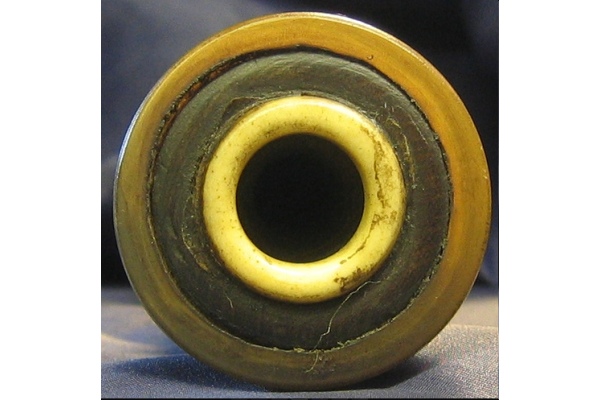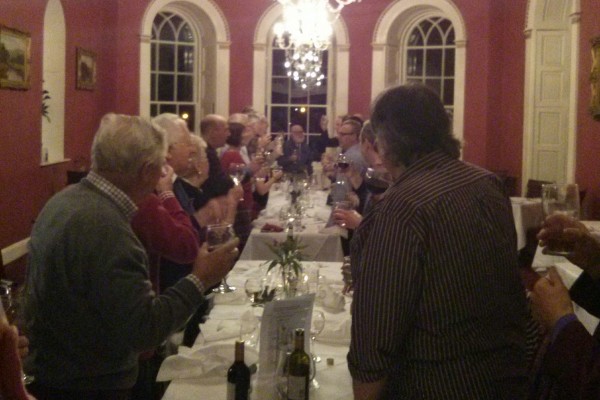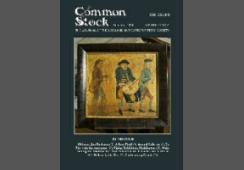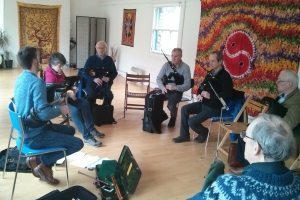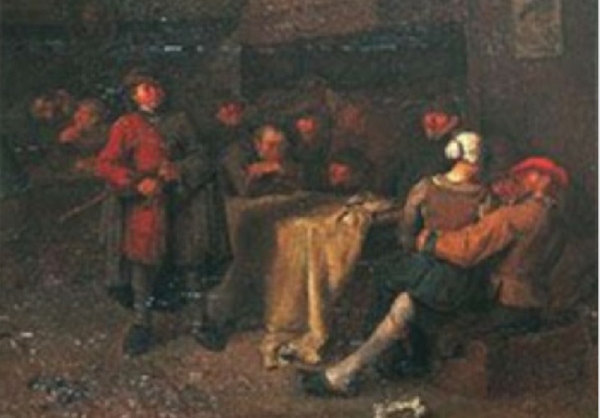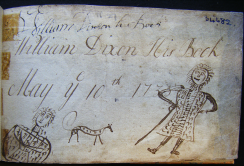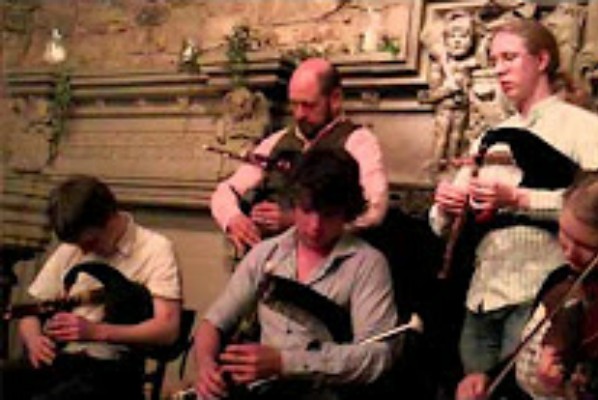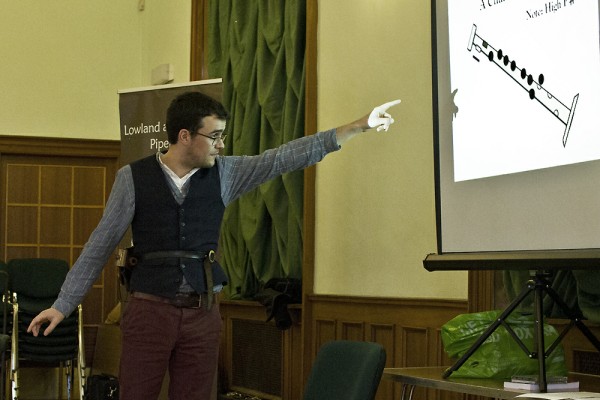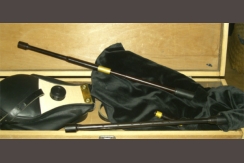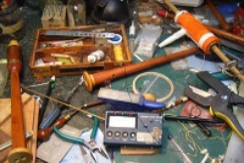An unlikely tune title and a mysterious image lead to a fascinating character in cultural history.
The titles of Scottish tunes published and in manuscript during the 18th century generally fall into one of three categories; they are either the names of some worthy or patron, the names of locations, or some part of the words of a popular song (many of whose complete words have been lost). There are, however, occasional titles whose meaning is almost totally obscure. Much has been written, for instance, about Linkumdoddie. Another of these I first came across while compiling a collection of tunes for the second volume of my history of piping in the Lowlands Welcome Home My Deari”. ‘The De’il on Twa Sticks’ appears in Rutherford’s Complete Collection of the most celebrated Country Dances, etc., published in London in 1756.
.jpg)
I spent some time wondering what could be the significance of this title, but did not at the time pursue it any further. However, I have recently found myself once more confronting this question, and by a most round-about route. It began when Peebles-based bagpipe maker Julian Goodacre came back from a week in the English Lake District with a framed copy of an 18th century engraving featuring a bagpiper. Unlikely as it may seem, there is a direct connection between this engraving and The Devil on Two Sticks.
The engraving carries the title ‘The March of the Medical Militants to the Siege of Warwick Lane Castle in the Year 1767’ and the words ‘J. June sculpt.’ John June was a successful engraver in mid-18th century London; this example of his work was published by Robert Sayer of Fleet Street, the same publisher who produced the engraving of the bellows piper from an original painting by Heemskerk which I printed in Welcome Home My Dearie.
So just what is going on here, and what is the connection with Rutherford’s tune? The answer to both questions turned out to be contained in the 1952 volume of the Journal of the History of Medical and Allied Sciences 1. According to an article there, this engraving records an extraordinary event that took place at the headquarters of the Royal College of Physicians on September 24th, 1767. The College was founded by Henry VIII in 1518 ‘with a view to the repression of irregular, ignorant and incompetent practitioners’. By the 18th century this meant in practice that no-one who had not graduated at either Oxford or Cambridge Universities could become a Fellow of the College, although they could be granted licence by the College to practice in London and its environs. At the same time, neither Catholics nor Dissenters could be admitted. By the middle of the 18th century perhaps the most prestigious and advanced school of Medicine in Europe was that at Edinburgh, and it seems to have been amongst Scottish doctors practicing in London that pressure for reform was most strongly felt. It is clear that there was also a political element involved; the College’s notion of medical education remained firmly grounded in the ancient texts of Hippocrates, whereas the Scottish and continental schools were advancing the cause of ‘scientific’ medicine, a cause which, in Scotland at least, frequently went hand in hand with the cause of political reform.
In 1767 a group of rebellious and dissident Licentiates formed themselves into the Society of Collegiate Physicians, a move prompted by the publication of a bye-law that no-one should be admitted into the Order of candidates who had not been created doctor of physic in the universities of Oxford or Cambridge. The first meeting of the new Society was chaired by Sir William Duncan Bart., and some thirty others were present, amongst which 19 had gained their degrees from Scottish universities.
On June 25th, 1767, Duncan and eight others, including William Hunter, Physician Extraordinary to Queen Charlotte, entered the College Committee meeting and sat down, insisting on their legal right to be there and announcing their intention of attending every future meeting. The meeting growing ‘very tumultuous’, the President announced that if they did not withdraw he ‘should be under the necessity of calling the constables’, whereon Hunter declared ‘that if any man or constable offered to lay hands on him … he would run him through the body’. The president was then obliged to dissolve the meeting.
The next meeting of the Committee was to be held on September 24th, before which a group of people gathered at the gates of the College’s Headquarters in Warwick Lane, near St Paul’s, who, when asked, said that they had been sent there by ‘some gentlemen in the Queen’s Arms Tavern in St Paul’s Church Yard’. Fearing that this was the work of the Licentiates who regularly dined at that tavern, the gates were locked and the key delivered to the College solicitor. 19 doctors eventually arrived at the gate, as well as two constables and the original group, now armed with staves. When they were refused entry, they broke down the gate and proceeded to the hall doors; Duncan was seen, together with a blacksmith, armed with large hammers; the blacksmith and one other then broke down the main door and, entering the building proceeded to break open other doors until they reached the meeting. Meanwhile at least 40 panes of window glass were broken by one of the Licentiates.
Despite the violence of this event, nothing seems to have been achieved, and matters remained unchanged although attempts to renew the demands for reform were made at the height of the revolutionary fervour that swept the country in the late 1790’s. The Society of Collegiate Physicians ceased to function soon after and reform of the Royal College did not come until 1834.
These details were gleaned from the journal article, which in turn was drawn from original records of the College, from the minute books of the Society and from a report of the Society written in 1795. None of these make any mention of the pipe and drum portrayed in the engraving. So how are we to interpret their appearance? A clue is given in a second engraving published in the Journal article which depicts the forced entry of the Licentiates into the meeting room of the College. The besieged Fellows are given quote-bubbles in which they are saying such things as
“These northern locusts want to govern everywhere” and “D-m their Scots pills. They have ruined the constitution of England”.
These words make it clear that the general tenure of the press reaction sided with the College Fellows2 who were seen as resisting what was at the time felt to be a takeover of government in London by the Scots3 , a feeling that had been epitomized by the prime-ministership of the Earl of Bute just four years before, and which had been given a popular voice by John Wilkes in his paper The North Briton. It is, then, in this context that we must view the presence of the drummer and piper at the head of the march.4
It is therefore not surprising that the bagpipes depicted are drawn from that vocabulary of stock images with which Londoners were familiar, having been first shown such an instrument in 1743 in the aftermath of the Black Watch Mutiny. Hugh Cheape showed the prevalence of this image throughout the 18th century, and also suggested that it had its origins in the much copied 17th century painting of a bagpiper by Abraham Bloemart. How or why this particular painting and its engraving (by Abraham’s son) became the source of so much bagpipe iconography remains unclear.

This is all well and good, but exactly what does it have to do with The Devil on Two Sticks? Well, the original article by Stevenson in the Journal of the History of Medicine makes reference to another article by Betsy – in which, Stevenson says, is discussed the appearance of the Warwick Lane revolt on the London stage. Fortunately for researchers, this article was printed in the same volume of the Journal, immediately after that of Stevenson. I was therefore able to establish that the satirical dramatist Samuel Foote had one of his greatest successes in 1768 with a play containing scenes which lampooned, not just this revolt, but the medical profession in general. Indeed, one scene from this drama, in which a novitiate physician, Dr Last, is examined by a character representing Sir William Browne (President of the College of Physicians)was so popular that it was often preformed as a separate piece between acts of other plays. Samuel Foote himself played Dr Last.
In the original play he also took another, that of ‘The Devil Upon Two Sticks’ from which the play took its name. Foote had embedded his satirical commentary on the Warwick Lane events in a play which was adapted from a work in French which had been a great success across Europe during the first part of the century, Le Diable Boiteux, by Alain-René Lesage5 , which told of the release of a devil trapped in a bottle, who, on his release is found to be lame and to support himself on two crutches.

The term is now sometimes used to describe the ‘diabolo’, the jugglers’ device, in which a ‘double-cone devil’ is made to spin on a string held between two sticks. I have been unable to establish whether this was the origin of Lesage’s notion of a crippled Devil, but an English translation was in its 7th edition by 1741.6 Rutherford’s tune may therefore have been in circulation a good while before he published it.
There is another unlikely connection between the tune and the Warwick Road incident. William Hunter, Physician Extraordinary to Queen Charlotte, used Samuel Foote as a subject of medical research, as a case study in his development of what we might now call ‘psychology’.
‘He holds a key place in the birth of modern celebrity culture – as even Lord Byron later recognised – and in the story then and now of our fascination with the famous. Thanks to Hunter, who used him as a case study, he holds his place in the history of medicine and in the history of disability, appearing on stage, post-amputation, and triumphing over physical adversity.’… ‘In trying to understand the workings of the mind, at the birth of what would now be termed “psychology”, Hunter used Foote as a case study and also used the most obvious metaphor for a Londoner of his era, the theatre itself, as a paradigm by which to understand the psyche.’7
William Hunter’s brother John was a Scottish surgeon, one of the most distinguished scientists of his day. He was an early advocate of careful observation and scientific method in medicine and is frequently described as the Father of Modern Surgery. He was a teacher, friend, and collaborator of, Edward Jenner, the inventor of the smallpox vaccine. He set up his own anatomy school in London and a museum – now known as the Hunterian – a collection of anatomical specimens and curiosities. He was a close friend of Samuel Foote but also treated him in his decline, and advised the surgeon, William Bromfeild, who conducted Foote’s leg amputation. He designed for Foote an articulated prosthesis, perhaps England’s first, which was constructed by the Drury Lane puppet makers.
For Foote himself had had a leg amputated in a manner which befits this extraordinary character. ‘The Theatre Royal, Haymarket, a theatre Foote ran and which holds the title “Theatre Royal” entirely because of him. It is only as a result of royal contrition after a disastrous regal practical joke led to Foote’s (unanaesthetised) leg amputation that his theatre was granted the Theatre Royal status at all.’8
‘Foote had been summoned to Methley House to add some spice to the entertainment of a royal house guest, the stage-struck Edward Augustus, Duke of York, the younger brother of George III. It seems that Foote, in his cocksure way, had been boasting his prowess as a horseman. As some kind of test or wager he was given one of the duke’s most ‘mettlesome’ stallions to ride. At the first touch of the spur the horse reared violently, flinging him down onto the cobbles of the stableyard. He broke his leg in two places, bone below his knee jagging out through the leather of his boot’.9 Horrified that the joke had so misfired, the Duke of York, a close personal friend and fellow guest at the hunt, asked if anything could be done for Foote. Immediately, Foote replied that all he wanted from life was a Royal Warrant and Patent for his ‘Little Theatre in the Hay’.
Despite some reluctance from King George III, the Royal Patent was granted, with a proviso: it was to last only the summer months, and only until Foote’s death. The restriction was designed to avoid the now obvious competition with the two patent theatres.
Victorious at his achievement, Foote agreed and, having refurbished and enlarged the building, the theatre reopened in 1767 as the Theatre Royal Haymarket. Meanwhile Foote, not done with his own theatrical career, launched into writing plays for one-legged roles, (including ‘The Devil on Two Sticks’ as well as ‘The Lame Lover’).10
‘On 6 June 1777 he collapsed onstage during a performance of The Devil upon Two Sticks. He lay there shaking till the curtain was brought down, and the prompter announced that Mr Foote was ‘suddenly affected with a paralytic stroke’.11
Acting on medical advice he started for the South of France, and arrived at Dover 20 Oct. 1777 on his way to Calais. He was in good spirits, joking with the servants at the Ship Inn. At breakfast next morning he was seized with a shivering fit, a second followed, and on the same day, 21 Oct. 1777, he died.
His body was removed to his house, Suffolk Street, Pall Mall East, by William Jewell, the treasurer to the Haymarket, who had been sent for, and on the Monday night following (3 Nov.) he was buried by torchlight in the west cloister in Westminster Abbey. He was smuggled as close to Poets’ Corner as his friends dared. But his burial was a hushed and hugger-mugger affair. By 1776 Foote’s name may have been one of the most celebrated in the English-speaking world, but by the time of his death he was more notorious than famous. He died only months after the conclusion of two of the most scandalous trials of the eighteenth century, in both of which he played major roles and in one of which he faced a charge of ‘sodomitical assault’.’12
For much of the detail of Foote’s life and career, I am indebted to Charles Nicholl’s review in The London Review of Books of Mr Foote’s Other Leg: Comedy, Tragedy and Murder in Georgian London by Ian Kelly.
Notes
1 An internet search for Warwick Lane eventually turned up a reference to this article. A complete run of the journal is in the Edinburgh University Library, George Square.
2 Although several papers printed letters of support for the Licentiates. See Public Advertiser (London, England), Monday, October 26, 1767; online at http://find.galegroup.com/bncn/basicSearch.do [18/09/2009]
3 These ‘rebel’ Licentiates were by no means insignificant physicians; their leader was Sir William Duncan Bart., whose family had long been established in Forfarshire, and who was the physician to George III; likewise, Hunter was physician to George’s wife Queen Caroline.
4 The banners which the marchers carry bear the slogan “delenda est Oxoni [and Cambigensis]”; this is a reference to the (then) famous remark from the Latin text of the Punic wars, which every Scots Grammar School student would have known “delenda est Carthage” [Carthage must be destroyed]. The unlikely fact of a ‘riotous’ protest march carrying its slogans in Latin is perhaps an indication of the uniqueness of this event. It may also be one of the last protest marches in which the protesters, as good Scots gentlemen, all carried swords.
5 Lesage, Alain-René, Le Diable Boiteux, 1707. The text is on-line at http://www.archive.org/details/asmodeusordevilu00lesa [18/09/2009]
6 Le Diable Boiteux: or, the Devil Upon Two Sticks, 7th edition, Tonson, J. and R, London, Eng.1741. For sale online http://www.biblio.com/books/195182178.html [18/09/2009]
7 Kelly, Ian, ‘Mr Foote: the one-legged Georgian transvestite who enthrals us still’ in https://www.telegraph.co.uk/theatre/what-to-see/mr-foote-the-one-legged-georgian-transvestite-who-enthrals-us-still/
8 ‘Mr Foote's Other Leg: Who's who?’. https://www.hampsteadtheatre.com/news/2015/06/mr-footes-other-leg-whos-who/
9 Charles Nicholl. ‘The Devil upon Two Sticks’ https://www.lrb.co.uk/v35/n10/charles-nicholl/the-devil-upon-two-sticks
10 Theatre Royal Haymarket. https://trh.co.uk/theatre-history/
11 https://www.hampsteadtheatre.com/news/2015/05/an-extract-from-mr-footes-other-leg-the-biography/
12 Charles Nicholl. ‘The Devil upon Two Sticks’ https://www.lrb.co.uk/v35/n10/charles-nicholl/the-devil-upon-two-sticks

